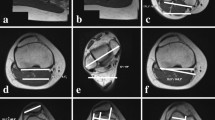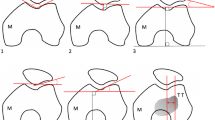Abstract
Background
Patellofemoral joint (PFJ) malalignment (lateral patella displacement and tilt) has been proposed as a cause of patellofemoral pain. Patella height and/or the morphologic features of the femoral trochlea may predispose one to patella malalignment.
Questions/purposes
The purposes of our study were to assess the associations among patella height, morphologic features of the trochlea, and measures of PFJ alignment and to determine which measures of patella height and morphologic features of the trochlea were the best predictors of PFJ alignment.
Methods
Measures of patella height (Insall-Salvati ratio and modified Insall-Salvati ratio), morphologic features of the trochlea (sulcus angle, trochlear angle, lateral trochlear inclination, medial trochlear inclination), and PFJ alignment (bisect offset and patella tilt angle) were assessed in 566 knees from the Multicenter Osteoarthritis Study.
Results
Bisect offset was correlated with the Insall-Salvati ratio (r = 0.25) and lateral trochlear inclination (r = −0.38). Patella tilt angle correlated with the trochlear angle (−0.27) and lateral trochlear inclination (−0.32). Linear regression models including the Insall-Salvati ratio and lateral trochlear inclination explained 20% and 11% of the variance in bisect offset and patella tilt angle, respectively.
Conclusions
Of the variables measured in the current study, the Insall-Salvati ratio and lateral trochlear inclination were the best predictors of lateral patella displacement and lateral tilt. This knowledge will aid clinicians in the identification of anatomic risk factors for PFJ malalignment and/or PFJ dysfunction.
Level of Evidence
Level III, diagnostic study. See the Guidelines for Authors for a complete description of levels of evidence.



Similar content being viewed by others
References
Ali SA, Helmer R, Terk MR. Analysis of the patellofemoral region on MRI: association of abnormal trochlear morphology with severe cartilage defects. AJR Am J Roentgenol. 2010;194:721–727.
Biedert RM, Albrecht S. The patellotrochlear index: a new index for assessing patellar height. Knee Surg Sports Traumatol Arthrosc. 2006;14:707–712.
Blackburne JS, Peel TE. A new method of measuring patellar height. J Bone Joint Surg Br. 1977;59:241–242.
Brattstroem H. Shape of the intercondylar groove normally and in recurrent dislocation of the patella: a clinical and x-ray–anatomical investigation. Acta Orthop Scand Suppl. 1964;68:1–148.
Carrillon Y, Abidi H, Dejour D, Fantino O, Moyen B, Tran-Minh VA. Patellar instability: assessment on MR images by measuring the lateral trochlear inclination-initial experience. Radiology. 2000;216:582–585.
Caton J. [Method of measuring the height of the patella][in French]. Acta Orthop Belg. 1989;55:385–386.
Felson DT, Niu J, Guermazi A, Roemer F, Aliabadi P, Clancy M, Torner J, Lewis CE, Nevitt MC. Correlation of the development of knee pain with enlarging bone marrow lesions on magnetic resonance imaging. Arthritis Rheum. 2007;56:2986–2992.
Fulkerson JP, Shea KP. Disorders of patellofemoral alignment. J Bone Joint Surg Am. 1990;72:1424–1429.
Grelsamer RP, Meadows S. The modified Insall-Salvati ratio for assessment of patellar height. Clin Orthop Relat Res. 1992;282:170–176.
Harbaugh CM, Wilson NA, Sheehan FT. Correlating femoral shape with patellar kinematics in patients with patellofemoral pain. J Orthop Res. 2010;28:865–872.
Hautamaa PV, Fithian DC, Kaufman KR, Daniel DM, Pohlmeyer AM. Medial soft tissue restraints in lateral patellar instability and repair. Clin Orthop Relat Res. 1998;349:174–182.
Huberti HH, Hayes WC. Patellofemoral contact pressures: the influence of q-angle and tendofemoral contact. J Bone Joint Surg Am. 1984;66:715–724.
Hunter DJ, Zhang YQ, Niu JB, Felson DT, Kwoh K, Newman A, Kritchevsky S, Harris T, Carbone L, Nevitt M. Patella malalignment, pain and patellofemoral progression: the Health ABC Study. Osteoarthritis Cartilage. 2007;15:1120–1127.
Insall J. Current concepts review: patellar pain. J Bone Joint Surg Am. 1982;64:147–152.
Insall J, Goldberg V, Salvati E. Recurrent dislocation and the high-riding patella. Clin Orthop Relat Res. 1972;88:67–69.
Insall J, Salvati E. Patella position in the normal knee joint. Radiology. 1971;101:101–104.
Kalichman L, Zhang Y, Niu J, Goggins J, Gale D, Felson DT, Hunter D. The association between patellar alignment and patellofemoral joint osteoarthritis features: an MRI study. Rheumatology (Oxford). 2007;46:1303–1308.
Kalichman L, Zhang Y, Niu J, Goggins J, Gale D, Zhu Y, Felson DT, Hunter DJ. The association between patellar alignment on magnetic resonance imaging and radiographic manifestations of knee osteoarthritis. Arthritis Res Ther. 2007;9:R26.
Kalichman L, Zhu Y, Zhang Y, Niu J, Gale D, Felson DT, Hunter D. The association between patella alignment and knee pain and function: an MRI study in persons with symptomatic knee osteoarthritis. Osteoarthritis Cartilage. 2007;15:1235–1240.
Kannus PA. Long patellar tendon: radiographic sign of patellofemoral pain syndrome: a prospective study. Radiology. 1992;185:859–863.
LaBella C. Patellofemoral pain syndrome: evaluation and treatment. Prim Care. 2004;31:977–1003.
LaValley MP, McLaughlin S, Goggins J, Gale D, Nevitt MC, Felson DT. The lateral view radiograph for assessment of the tibiofemoral joint space in knee osteoarthritis: its reliability, sensitivity to change, and longitudinal validity. Arthritis Rheum. 2005;52:3542–3547.
Merican AM, Amis AA. Iliotibial band tension affects patellofemoral and tibiofemoral kinematics. J Biomech. 2009;42:1539–1546.
Moller BN, Moller-Larsen F, Frich LH. Chondromalacia induced by patellar subluxation in the rabbit. Acta Orthop Scand. 1989;60:188–191.
Neyret P, Robinson AH, Le Coultre B, Lapra C, Chambat P. Patellar tendon length: the factor in patellar instability? Knee. 2002;9:3–6.
Nomura E, Horiuchi Y, Kihara M. Medial patellofemoral ligament restraint in lateral patellar translation and reconstruction. Knee. 2000;7:121–127.
Powers CM. Patellar kinematics, part I: the influence of vastus muscle activity in subjects with and without patellofemoral pain. Phys Ther. 2000;80:956–964.
Powers CM. Patellar kinematics, part II: the influence of the depth of the trochlear groove in subjects with and without patellofemoral pain. Phys Ther. 2000;80:965–978.
Powers CM, Shellock FG, Pfaff M. Quantification of patellar tracking using kinematic MRI. J Magn Reson Imaging. 1998;8:724–732.
Powers CM, Ward SR, Fredericson M, Guillet M, Shellock FG. Patellofemoral kinematics during weight-bearing and non-weight-bearing knee extension in persons with lateral subluxation of the patella: a preliminary study. J Orthop Sports Phys Ther. 2003;33:677–685.
Schulthies SS, Francis RS, Fisher AG, Van de Graaff KM. Does the Q angle reflect the force on the patella in the frontal plane? Phys Ther. 1995;75:24–30.
Souza DR, Gross MT. Comparison of vastus medialis obliquus: vastus lateralis muscle integrated electromyographic ratios between healthy subjects and patients with patellofemoral pain. Phys Ther. 1991;71:310–316; discussion 317–320.
Souza RB, Draper CE, Fredericson M, Powers CM. Femur rotation and patellofemoral joint kinematics: a weight-bearing magnetic resonance imaging analysis. J Orthop Sports Phys Ther. 2010;40:277–285.
Stefanik JJ, Roemer FW, Zumwalt AC, Zhu Y, Gross KD, Lynch JA, Frey-Law LA, Lewis CE, Guermazi A, Powers CM, Felson DT. Association between measures of trochlear morphology and structural features of patellofemoral joint osteoarthritis on MRI: the MOST study. J Orthop Res. 2012;30:1–8.
Stefanik JJ, Zhu Y, Zumwalt AC, Gross KD, Clancy M, Lynch JA, Frey Law LA, Lewis CE, Roemer FW, Powers CM, Guermazi A, Felson DT. Association between patella alta and the prevalence and worsening of structural features of patellofemoral joint osteoarthritis: the multicenter osteoarthritis study. Arthritis Care Res (Hoboken). 2010;62:1258–1265.
Ward SR, Shellock FG, Terk MR, Salsich GB, Powers CM. Assessment of patellofemoral relationships using kinematic MRI: comparison between qualitative and quantitative methods. J Magn Reson Imaging. 2002;16:69–74.
Ward SR, Terk MR, Powers CM. Patella alta: association with patellofemoral alignment and changes in contact area during weight-bearing. J Bone Joint Surg Am. 2007;89:1749–1755.
Wilson T. The measurement of patellar alignment in patellofemoral pain syndrome: are we confusing assumptions with evidence? J Orthop Sports Phys Ther. 2007;37:330–341.
Acknowledgments
We thank the MOST study participants.
Author information
Authors and Affiliations
Corresponding author
Additional information
The Multicenter Osteoarthritis Study was supported by the National Institutes of Health (NIH) (grants U01-AG18820, U01-AG18832, U01-AG18947, U01-AG19069, and AR-47785). One of the author’s (JJS) work was supported by a doctoral dissertation award from the Arthritis Foundation and NIH grant T32AR007598. He is currently supported by a Postdoctoral Fellowship from the Arthritis Foundation and the Research Scientist Development Award from the American College of Rheumatology.
All ICMJE Conflict of Interest Forms for authors and Clinical Orthopaedics and Related Research editors and board members are on file with the publication and can be viewed on request.
Each author certifies that his or her institution approved the human protocol for this investigation, that all investigations were conducted in conformity with ethical principles of research, and that informed consent for participation in the study was obtained. One author (CMP) confirms that no institutional review board approval was required from his institution.
Each author certifies that all investigations were conducted in conformity with ethical principles of research, and that informed consent for participation in the study was obtained from the institutions that supplied data.
About this article
Cite this article
Stefanik, J.J., Zumwalt, A.C., Segal, N.A. et al. Association Between Measures of Patella Height, Morphologic Features of the Trochlea, and Patellofemoral Joint Alignment: The MOST Study. Clin Orthop Relat Res 471, 2641–2648 (2013). https://doi.org/10.1007/s11999-013-2942-6
Received:
Accepted:
Published:
Issue Date:
DOI: https://doi.org/10.1007/s11999-013-2942-6




